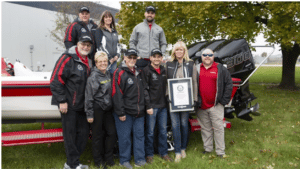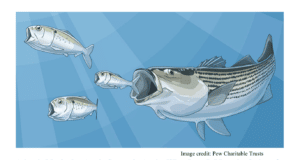Some in my contingent were questioning the wisdom of putting 10 members of our extended family and four friends together in a four-bedroom beach rental at Tarpon Springs, Florida. After two hours of unloading and stowing gear, groceries and beach towels, the question mark was followed by an exclamation point. Add another hour for a trip to the launch ramp to drop our Evinrude-powered Bluewater offshore boat, two Sea-Doos, a Wake 215 and a GTI SE 155, and we were suddenly tired enough to rest.
We were catching our breath when a neighbor walked by holding something behind his back.
“Look what I caught out there!” He was standing there in blood-stained fishing clothes and a well-worn hat. Sometimes beach-rental tenants aren’t too popular among the surrounding homeowners, so we were open-mouthed. He was pointing to Honeymoon Island, about four miles out from our temporary home, then brought up his hidden hand. It held a shark about two feet long.
“Yep, hook up a shrimp or cut bait and throw it out right off the tip of the island. You can catch one, too.”
But with Sea-Doos, and a plan to jump off the back of them to snorkel, sharks weren’t really what we wanted to hear about. We were here to find some of the infamous sponges near Tarpon Springs, and to do that, we’d also stowed along our extra secret weapon — an Airline hookah system by Joe Sink. Powered by a Honda mower engine, it sports three diving regulators, each with 60 feet of hose — ideal for scouring the waters for our quarry.
To get a clue about where to look, we headed to the Tarpon Springs Sponge Docks hoping to talk to the professional divers. On the way, we spotted snorkelers in the beachfront park. Hunting sponges, we presumed.
“I wonder how many they’ve found,” I asked my wife. She and Amy, my 12-year old daughter, were more intent on the beach layout, so my question went unanswered.
It’s tempting to call the Sponge Docks the tourist district, thanks to its numerous shops and restaurants neatly posted along the riverfront road. The river is lined bow to stern with tour boats, but in truth, the community’s sponge divers trade here too, offloading their sponges while talking to visitors.
That’s what Solan Zagorianos and his wife were doing when we arrived. Two or three piles of sponges — maybe a thousand of three various species in them, ranging from grapefruit-size to basketballs — lay on deck. They rinsed and rolled them, letting the last remains of animal matter flow from their pores as they dried. What remains is the absorbent skeleton that gives them their name.
Then we got our first surprise.
“Where do you find them?” we asked, ready to take mental notes, hopeful of finding a few of our own sponges to display for trophies.
“About 60 miles from here,” said Solan, “20 miles offshore of Homosassa.”
We’d just left that area, more than an hour away by highway and far out of fuel range for our Sea-Doos.
“We don’t find sponges around here much,” said Solan. He nodded toward the piles. “It took us two weeks of hunting to find those.”
Suddenly beach combing and snorkeling for sand dollars and sea shells sounded more enticing. So we returned to our sponge dock and headed to sea. A chase boat and a pair of watercraft are the ideal combination for exploring new territory.
At Anclote Key, just outside the mouth of the Anclote River, we pulled the boats up in the shallows and the kids donned snorkels. They found small shells and sand dollars, chased minnows and splashed around. The dads waded nearby and kept an eye out from a distance. The rest of the crew relaxed on the chase boat, sipping iced tea and listening to the ’70s channel on Sirius satellite radio.
Anclote Key is the pine-shaded home of a lighthouse, hiking trails and tent campsites. Camping is a tempting boating adventure there, but only in the windy, drier spring months when insects haven’t reached their seasonal population highs.
“There’s nothing here!” shouted one of the kids. The minnows had gone to deeper, safer water, so new hunting grounds were needed.
The nameless next island was more a spit of sand than an island. We beached the Sea-Doos and boat and started to explore. Amy and I decided to hike around barefoot. Soon we discovered a grassy area roped off and posted with “Keep Out” signs. Rare shorebirds were nesting there. We couldn’t see the nests, but several of the birds sulked around, presumably trying desperately to protect their nests. We felt guilty just being there.
“Let’s go, Dad,” Amy said. “I don’t think they like us much.” And, in fact, one had taken to divebombing us. We backed away and returned to the beach, the warming light of the sun now on its downward slide toward the Gulf of Mexico.
The next day, we grabbed the rods, shrimp and some chum to try and bait up some dinner. But three miles off the seaward shore of Anclote, the seas were nudging two feet, and it quickly became obvious some of our anglers were soon to turn into chummers.
“I want to go in,” said James my oldest nephew. You could see his energy drink wasn’t doing well in his belly. Amy didn’t look much better. We dropped back in the lee of the key to give them calmer water.
“Let’s try a little here in the calmer water, then we’ll ride the Sea-Doos. OK?” I asked. The idea brought a near mutiny, but just then a rod bobbed.
“I got it,” about three of the kids yelled in unison. “It” was about 5 inches long. Two more miniature aquarium specimens sealed the mutiny pact, and it was obvious we’d have to head back to a seafood shop near the Sponge Docks if fish were to find their way to our grill.
My oldest son, Justin, and my brother, Brent, drove the ‘Doos with a pair of kids on each. We zoomed up to the Anclote River and then puttered through the no-wake zones to the Sponge Docks. Even the kids were OK with the slow speeds as they gawked up at the tall booms of shrimp boats and trawlers. They steered clear of tour boats as I followed along in the Bluewater.
But 20 minutes of “no wake” goes a long way on a watercraft capable of 65-mph, so we worked our way downstream and opened them back up in the bay behind Anclote Key. We couldn’t hear the squeals of laughter over the Bluewater’s stereo, but the smiles flashed from hundreds of yards away. By the time they were put on the trailer, the sun was setting and the sunburns were just warming up.
Shopping is a good way to let the sunburns heal, so we strolled the Sponge Docks again, ducking into ice-cream parlors and sponge boutiques. We spotted a seafood shop. Linda nudged me in the ribs.
“Maybe we should fish around there,” she gigged.
I spotted a leather shop that boasted of eel-skin products at two for one. I bought a wallet for $19. Nope, the twofer deal didn’t apply to wallets. Still, not a bad buy … and a timely one, considering the condition of my current wallet.
Farther down the walk, we spotted a cigar roller. Not much of a smoker, I’m occasionally tempted by a few puffs on a well-rolled stogie. Brent and photographer Gary Bogdon chatted and joked with the amiable Cuban-American as he rolled the soft, fragrant leaves.
Outdoors is the best place to smoke a cigar, or better yet, the boat dock when it’s bathed in an orange sunset, with the sound of shorebirds wading in the flats nearby, and maybe the tinkle of ice cubes in a well-mixed refreshment. Add a little laughter to round it off. The better way to finish a day, and we had three more to go.
Our Boats
Sea-Doo GTi
This three-seat, 155-horsepower personal watercraft comes with a “learning key” that reduces top speed and acceleration, giving novice riders a chance to get the feel for the boat without getting the feel for face-plants. The standard key gives it full power for more-experienced riders. Also available in a 130-horsepower model and at a bargain price, we found it has plenty of storage for hauling fins and masks.
Sea-Doo Wake
The Wake’s engine’s horsepower is beefed up with a supercharger, giving it 215 horsepower, for yanking wake-board and wake-skate riders out of the water. It’s ideal for touring, but when equipped with an optional ballast tank, it makes an impressive wake for riders. The tow pylon is standard and provides a towpoint at the correct level for fun riding.
Bluewater 2550
Our chase boat was Bluewater’s center-console offshore boat powered by twin 200-horsepower Evinrude outboards made by the same company that makes Sea-Doos. Few combinations make for more fun on the water than a boat and a pair of personal watercraft. With Lowrance electronics, our 2550 also gave us the power to find fish and to chart a course anywhere we wanted to take the watercraft.
Snorkels and Stuff
Keeping kids interested in the underwater events isn’t hard if they’re comfortable and if they get a quick look at something happening.
1. If you can, buy each snorkeler his/her own mask and snorkel. We found some U.S. Diver kits inexpensively priced at Wal-Mart.
2. Start out in shallow water to ease them into the project. It’s much less intimidating to check out the minnows in two feet of water and work your way deeper.
3. Teach your crew about nature. Each shell or object is (or was) an individual’s home. If the shell is still occupied, put it back.
4. Keep an eye on all snorkelers nearby and from above. It’s hard to keep track of everyone if you’re face down in the water as well.
5. After snorkeling, recruit the swimmers to wash-up detail using fresh water to eliminate salt on the gear.
Finding Our Way
* We found our summer rental — a four-bedroom, two-bathroom with a screened-in pool, dock and all the kitchen and living furnishings we needed for the week — for $2,400 at vrbo.com.
* Best launch: Anclote River Park, fun-florida-getaways.com/anclote-park-snapshot.cfm
* For more information about boating in the Tarpon Springs area, call the Chamber of Commerce at 727-937-6109 or go to tarponsprings.com









